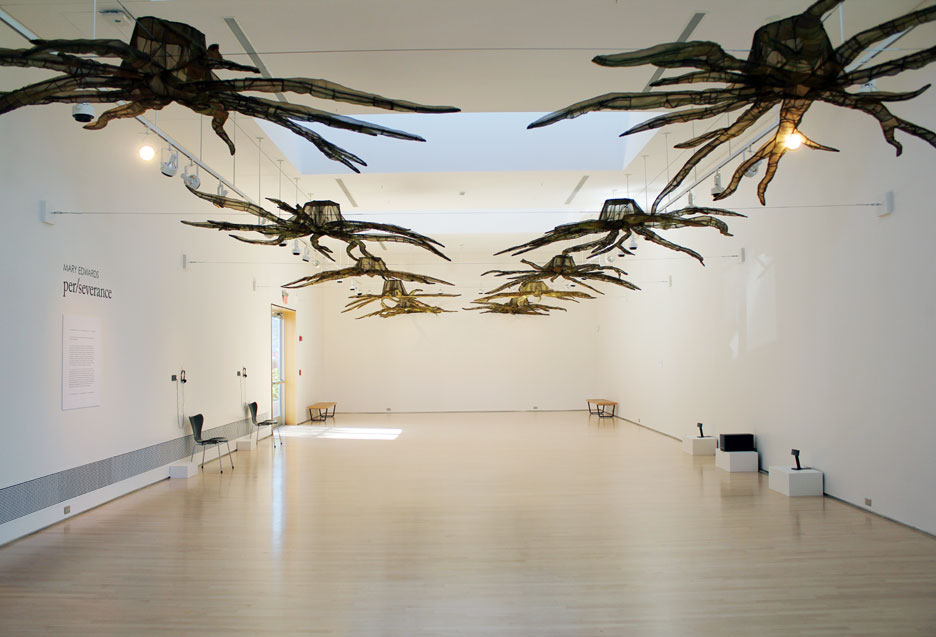|
|


per/severance
A sound installation by Mary Edwards
this bright morning
An installation by Charlotte Hamlin
September 5 – October 17, 2013
"No experience has been too unimportant, and the smallest event unfolds like a fate, and fate itself is like a wonderful, wide fabric in which every thread is guided by an infinitely tender hand and laid alongside another thread and is held and supported by a hundred others."
—Rainer Maria Rilke
In my neighborhood, there is an arboretum and cemetery that I walk through almost every day. Built in 1856, the place, Juniper Hill, is a wonderful example of a movement in the 19th century that wove landscape architecture and cemetery design together. This notion was inspired by prevailing romantic ideas about nature, art, and death and provided an escape from the realities of urban life. These park-like settings gave opportunities for everyone to enjoy serenity and civility and to be introduced to works of art and sculpture in a safe and natural, although manufactured, environment.
As a planned urban space, it was also developed to mirror, as much as possible, the look and feel of a natural place; winding paths, trees, and ponds, along with public sculpture and tranquil settings. It is a model of a planned environment that is respectful of the landscape but also one that is intended to enhance it, to make it better than natural.
The artists in the exhibition chose to reflect in their works two examples of human intervention and manipulation — and in some cases — management of the landscape.
Composer and sound artist Mary Edwards has created an interpretive soundscape of the Quequechan River. The river 's history is familiar to those of us who live and work in Fall River. For more than a century it was the lifeblood of the textile industry. Its course runs through the city, shallow and sluggish along its southern end, and fast and furious as it heads down toward the bay. In service to manufacturing, the river was modified so much that its original path is unknown. More recently it was buried under the city to accommodate the expansion of Interstate 195. Edwards came to Fall River several times to study the river, to understand its relationship to the city, and to find the remaining places where it can still be seen, and heard. Her sound installation is evocative of many things, the memories that the water still carries, the conversation it would have if someone were there to listen.
Charlotte Hamlin is a sculptor who often works with textiles, and for the exhibition she worked with a traditional Korean cloth making process called Bojagi. In her re-imagining of an All ée, or tree lined walkway, the roots of each tree are suspended above us. The term Allée typically describes avenues often found in parks and cultivated landscapes. The effect of the traditional form is one that emphasizes a "coming to" or arrival to a particular place or feature, such as a fountain or other place in a garden 1. Constructed with sewn and hand dyed organza over delicately constructed armatures, Hamlin has transformed this idea into a musing about life, and death, about impermanence, about that which remains after everything else is gone.
Notions of 19th century idealism and representations of nature bind neither Hamlin nor Edwards, but their works can act as a symbolic reminder to those ideals. Each has refocused the lens on human intervention on the landscape, and, more importantly, the results of that intervention. We live in an increasingly complex tangle of busy expectations – our work and home and socially networked lives integrated in ways we could not have imagined until recently–the results of which seem to encourage distraction. per/severance and this bright morning are reminders and a call to each of us to give renewed consideration to a state of presence, continuity, and renewal in spite, or rather, because, of the impermanence of things.
Kathleen Hancock
Director
Mary Edwards
per/severance
"Is it that places retain memory, or that spaces have the unusual power to trigger memory?"
—Carolyn Christov-Bakargiev
I am a composer who uses sound as an environmental or architectural element with the objective to enhance the listener 's spatial experience, while creating a narrative immersion through cinematic scoring techniques. My current body of work reflects the conflict of desire and uncertainty that seems to simultaneously haunt intimate (if sometimes interim) spaces, each drawing on the relationship we have with temporality, where the anticipation of travel or movement often overshadows the destination. The ambience signifies the essence and impermanence of nature and architecture, evoking both absence and presence through sound. I practice what Juhani Pallasmaa calls "Sensuous Minimalism," where a certain neutrality, restraint and silence are an inherent quality of the discipline: "The significance (of architecture) is not in its material form, but in its capacity to reveal deeper layers of existence."
The 2.7 mile-long Quequechan River, once the centerpiece of the 19th Century Fall River, Massachusetts textile industry, has since been partially obscured by the mills built in that era, as well as tragedies and initiatives occurring throughout the 20th and early 21st Centuries. per/severance implies both a tenacity and a detachment evidenced by the predicament of the river. Its memory and "voice" are represented by a collection of subtle sounds: its fluid origins ranging from a purely ecological juncture of its most natural state prior to industrialization, to a human-altered waterscape; distant contrapuntal Siren-inspired choruses alternating between alluring resonance and foreboding dissonance; and faint reverberations that hearken to the height and decline of the mills and the vision to "daylight" the falls once again.
Charlotte Hamlin
this bright morning
The hours pass; the imperative nature of our numerous tasks drags us forward, as
beasts of habit, flopping into our comfort.
We try to make our small mark, to say good morning, to incur love.
The unexpected happens.
We recoil. We swear we won 't forget this.
And shift the scope accordingly.
Days pass.
Listen to per/severance here:
Original article published 5 October 2013 can be found here. |
© 2015 MARY EDWARDS. ALL RIGHTS RESERVED
|

